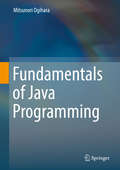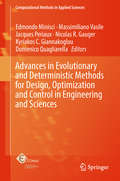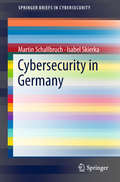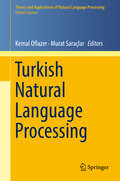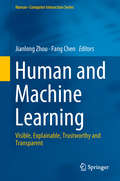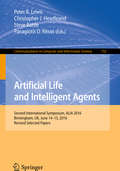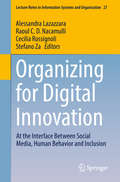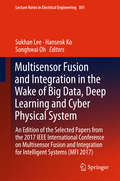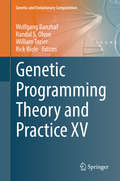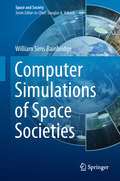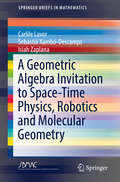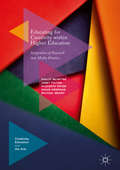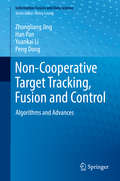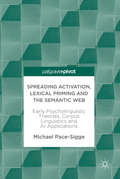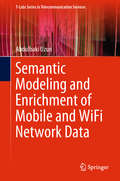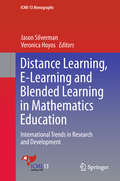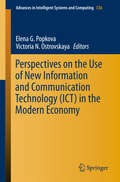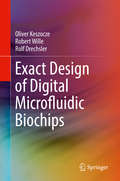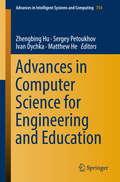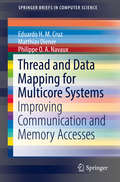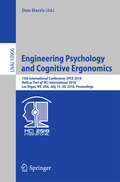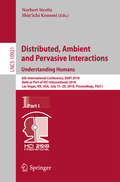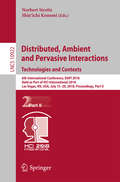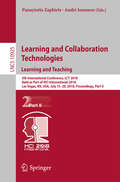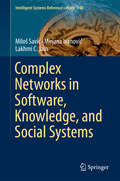- Table View
- List View
Fundamentals of Java Programming
by Mitsunori OgiharaMaking extensive use of examples, this textbook on Java programming teaches the fundamental skills for getting started in a command-line environment. Meant to be used for a one-semester course to build solid foundations in Java, Fundamentals of Java Programming eschews second-semester content to concentrate on over 180 code examples and 250 exercises.Key object classes (String, Scanner, PrintStream, Arrays, and File) are included to get started in Java programming. The programs are explained with almost line-by-line descriptions, also with chapter-by-chapter coding exercises.Teaching resources include solutions to the exercises, as well as digital lecture slides.
Advances in Evolutionary and Deterministic Methods for Design, Optimization and Control in Engineering and Sciences (Computational Methods in Applied Sciences #48)
by Edmondo Minisci Massimiliano Vasile Jacques Periaux Nicolas R. Gauger Kyriakos C. Giannakoglou Domenico QuagliarellaThis volume presents up-to-date material on the state of the art in evolutionary and deterministic methods for design, optimization and control with applications to industrial and societal problems from Europe, Asia, and America.EUROGEN 2015 was the 11th of a series of International Conferences devoted to bringing together specialists from universities, research institutions and industries developing or applying evolutionary and deterministic methods in design optimization, with emphasis on solving industrial and societal problems. The conference was organised around a number of parallel symposia, regular sessions, and keynote lectures focused on surrogate-based optimization in aerodynamic design, adjoint methods for steady & unsteady optimization, multi-disciplinary design optimization, holistic optimization in marine design, game strategies combined with evolutionary computation, optimization under uncertainty, topology optimization, optimal planning, shape optimization, and production scheduling.
Cybersecurity in Germany (SpringerBriefs in Cybersecurity)
by Martin Schallbruch Isabel SkierkaIn 2016, Germany's government presented its third cybersecurity strategy, which aims to strengthen the national cyber defence architecture, cooperation between the state and industry, and individual users’ agency. For many years, Germany has followed/adopted a preventive and engineering approach to cybersecurity, which emphasizes technological control of security threats in cyberspace over political, diplomatic and military approaches. Accordingly, the technically oriented Federal Office for Information Security (BSI) has played a leading role in Germany’s national cybersecurity architecture. Only in 2016 did the military expand and reorganize its cyber defence capabilities. Moreover, cybersecurity is inextricably linked to data protection, which is particularly emphasised in Germany and has gained high public attention since Edward Snowden’s revelations. On the basis of official documents and their insights from many years of experience in cybersecurity policy, the two authors describe cyber security in Germany in the light of these German peculiarities. They explain the public perception of cybersecurity, its strong link with data protection in Germany, the evolution of Germany's cybersecurity strategies, and the current organisation of cybersecurity across the government and industry. The Brief takes stock of past developments and works out the present and future gaps and priorities in Germany’s cybersecurity policy and strategy, which will be decisive for Germany’s political role in Europe and beyond. This includes the cybersecurity priorities formulated by the current German government which took office in the spring of 2018.
Turkish Natural Language Processing (Theory and Applications of Natural Language Processing)
by Kemal Oflazer Murat SaraçlarThis book brings together work on Turkish natural language and speech processing over the last 25 years, covering numerous fundamental tasks ranging from morphological processing and language modeling, to full-fledged deep parsing and machine translation, as well as computational resources developed along the way to enable most of this work. Owing to its complex morphology and free constituent order, Turkish has proved to be a fascinating language for natural language and speech processing research and applications.After an overview of the aspects of Turkish that make it challenging for natural language and speech processing tasks, this book discusses in detail the main tasks and applications of Turkish natural language and speech processing. A compendium of the work on Turkish natural language and speech processing, it is a valuable reference for new researchers considering computational work on Turkish, as well as a one-stop resource for commercial and research institutions planning to develop applications for Turkish. It also serves as a blueprint for similar work on other Turkic languages such as Azeri, Turkmen and Uzbek.
Human and Machine Learning: Visible, Explainable, Trustworthy and Transparent (Human–Computer Interaction Series)
by Jianlong Zhou Fang ChenWith an evolutionary advancement of Machine Learning (ML) algorithms, a rapid increase of data volumes and a significant improvement of computation powers, machine learning becomes hot in different applications. However, because of the nature of “black-box” in ML methods, ML still needs to be interpreted to link human and machine learning for transparency and user acceptance of delivered solutions. This edited book addresses such links from the perspectives of visualisation, explanation, trustworthiness and transparency. The book establishes the link between human and machine learning by exploring transparency in machine learning, visual explanation of ML processes, algorithmic explanation of ML models, human cognitive responses in ML-based decision making, human evaluation of machine learning and domain knowledge in transparent ML applications. This is the first book of its kind to systematically understand the current active research activities and outcomes related to human and machine learning. The book will not only inspire researchers to passionately develop new algorithms incorporating human for human-centred ML algorithms, resulting in the overall advancement of ML, but also help ML practitioners proactively use ML outputs for informative and trustworthy decision making. This book is intended for researchers and practitioners involved with machine learning and its applications. The book will especially benefit researchers in areas like artificial intelligence, decision support systems and human-computer interaction.
Artificial Life and Intelligent Agents: First International Symposium, ALIA 2014, Bangor, UK, November 5-6, 2014. Revised Selected Papers (Communications In Computer And Information Science #732)
by Christopher J. Headleand Peter R. Lewis Panagiotis D. Ritsos Steve BattleThis book constitutes the refereed proceedings of the Second International Symposium on Artificial Life and Intelligent Agents, ALIA 2016, held in Birmingham, UK, in June 2016. The 8 revised full papers and three revised short papers presented together with two demo papers were carefully reviewed and selected from 25 submissions. The papers are organized in topical sections on modelling; robotics; bio-inspired problem solving; human-like systems; applications and games.
Organizing for Digital Innovation: At the Interface Between Social Media, Human Behavior and Inclusion (Lecture Notes in Information Systems and Organisation #27)
by Alessandra Lazazzara Raoul C.D. Nacamulli Cecilia Rossignoli Stefano ZaThis book presents a collection of research papers exploring the human side of digital innovation management, with a specific focus on what people say and share on social media, how they respond to the introduction of specific IT tools, and how digital innovations are impacting sustainability and inclusion. Given the plurality of views that it offers, the book is particularly relevant for digital technology users, companies, scientists and governments. The overall spread of digital and technological advances is enhanced or hampered by people’s skills, behaviors and attitudes. The challenge of balancing the digital dimension with humans situated in specific contexts, relations and networks has sparked a growing interest in how people use and respond to digital innovations. The content of the book is based on a selection of the best papers – original double-blind peer-reviewed contributions – presented at the annual conference of the Italian chapter of the AIS, which was held in Milan, Italy, in October 2017.
Multisensor Fusion and Integration in the Wake of Big Data, Deep Learning and Cyber Physical System: An Edition of the Selected Papers from the 2017 IEEE International Conference on Multisensor Fusion and Integration for Intelligent Systems (MFI 2017) (Lecture Notes in Electrical Engineering #501)
by Sukhan Lee Hanseok Ko Songhwai OhThis book includes selected papers from the 13th IEEE International Conference on Multisensor Integration and Fusion for Intelligent Systems (MFI 2017) held in Daegu, Korea, November 16–22, 2017. It covers various topics, including sensor/actuator networks, distributed and cloud architectures, bio-inspired systems and evolutionary approaches, methods of cognitive sensor fusion, Bayesian approaches, fuzzy systems and neural networks, biomedical applications, autonomous land, sea and air vehicles, localization, tracking, SLAM, 3D perception, manipulation with multifinger hands, robotics, micro/nano systems, information fusion and sensors, and multimodal integration in HCI and HRI. The book is intended for robotics scientists, data and information fusion scientists, researchers and professionals at universities, research institutes and laboratories.
Genetic Programming Theory and Practice XV (Genetic and Evolutionary Computation)
by Wolfgang Banzhaf Randal S. Olson William Tozier Rick RioloThese contributions, written by the foremost international researchers and practitioners of Genetic Programming (GP), explore the synergy between theoretical and empirical results on real-world problems, producing a comprehensive view of the state of the art in GP. Topics in this volume include: exploiting subprograms in genetic programming, schema frequencies in GP, Accessible AI, GP for Big Data, lexicase selection, symbolic regression techniques, co-evolution of GP and LCS, and applying ecological principles to GP. It also covers several chapters on best practices and lessons learned from hands-on experience. Readers will discover large-scale, real-world applications of GP to a variety of problem domains via in-depth presentations of the latest and most significant results.
Computer Simulations of Space Societies (Space and Society)
by William Sims BainbridgeAt the intersection of astronautics, computer science, and social science, this book introduces the challenges and insights associated with computer simulation of human society in outer space, and of the dynamics of terrestrial enthusiasm for space exploration. Never before have so many dynamic representations of space-related social systems existed, some deeply analyzing the logical implications of social-scientific theories, and others open for experience by the general public as computer-generated virtual worlds. Fascinating software ranges from multi-agent artificial intelligence models of civilization, to space-oriented massively multiplayer online games, to educational programs suitable for schools or even for the world's space exploration agencies. At the present time, when actual forays by humans into space are scarce, computer simulations of space societies are an excellent way to prepare for a renaissance of exploration beyond the bounds of Earth.
A Geometric Algebra Invitation to Space-Time Physics, Robotics and Molecular Geometry (SpringerBriefs in Mathematics)
by Carlile Lavor Sebastià Xambó-Descamps Isiah ZaplanaThis book offers a gentle introduction to key elements of Geometric Algebra, along with their applications in Physics, Robotics and Molecular Geometry. Major applications covered are the physics of space-time, including Maxwell electromagnetism and the Dirac equation; robotics, including formulations for the forward and inverse kinematics and an overview of the singularity problem for serial robots; and molecular geometry, with 3D-protein structure calculations using NMR data. The book is primarily intended for graduate students and advanced undergraduates in related fields, but can also benefit professionals in search of a pedagogical presentation of these subjects.
Educating for Creativity within Higher Education: Integration of Research into Media Practice (Creativity, Education and the Arts)
by Phillip McIntyre Janet Fulton Elizabeth Paton Susan Kerrigan Michael MeanyThis book provides innovative insights into how creativity can be taught within higher education. Preparing students for employment in a dynamic set of global creative industries requires those students to not only be resilient and entrepreneurial, but also to be locally focused while being globally aware. Therefore it is imperative that they acquire a thorough understanding of creative processes and practice as they try to keep pace with worldwide digital trends. As the creation of media messages is a fundamental aspect of global creative industries, and that numerous concerns practitioners face are based upon a certain understanding of creativity, the authors propose an exploration of what creativity is in terms of research, and then apply it pedagogically. Drawing on extensive empirical research, the authors pose the thought-provoking question of whether creativity can be taught. This volume will be of interest to both students and scholars of creativity and higher education as well as to creatively-based practitioners more widely.
Non-Cooperative Target Tracking, Fusion and Control: Algorithms and Advances (Information Fusion and Data Science)
by Zhongliang Jing Han Pan Yuankai Li Peng DongThis book gives a concise and comprehensive overview of non-cooperative target tracking, fusion and control. Focusing on algorithms rather than theories for non-cooperative targets including air and space-borne targets, this work explores a number of advanced techniques, including Gaussian mixture cardinalized probability hypothesis density (CPHD) filter, optimization on manifold, construction of filter banks and tight frames, structured sparse representation, and others. Containing a variety of illustrative and computational examples, Non-cooperative Target Tracking, Fusion and Control will be useful for students as well as engineers with an interest in information fusion, aerospace applications, radar data processing and remote sensing.
Spreading Activation, Lexical Priming and the Semantic Web: Early Psycholinguistic Theories, Corpus Linguistics and AI Applications
by Michael Pace-SiggeThis book explores the interconnections between linguistics and Artificial Intelligence (AI) research, their mutually influential theories and developments, and the areas where these two groups can still learn from each other. It begins with a brief history of artificial intelligence theories focusing on figures including Alan Turing and M. Ross Quillian and the key concepts of priming, spread-activation and the semantic web. The author details the origins of the theory of lexical priming in early AI research and how it can be used to explain structures of language that corpus linguists have uncovered. He explores how the idea of mirroring the mind’s language processing has been adopted to create machines that can be taught to listen and understand human speech in a way that goes beyond a fixed set of commands. In doing so, he reveals how the latest research into the semantic web and Natural Language Processing has developed from its early roots. The book moves on to describe how the technology has evolved with the adoption of inference concepts, probabilistic grammar models, and deep neural networks in order to fine-tune the latest language-processing and translation tools. This engaging book offers thought-provoking insights to corpus linguists, computational linguists and those working in AI and NLP.
Semantic Modeling and Enrichment of Mobile and WiFi Network Data (T-Labs Series in Telecommunication Services)
by Abdulbaki UzunThis book discusses the fusion of mobile and WiFi network data with semantic technologies and diverse context sources for offering semantically enriched context-aware services in the telecommunications domain.It presents the OpenMobileNetwork as a platform for providing estimated and semantically enriched mobile and WiFi network topology data using the principles of Linked Data. This platform is based on the OpenMobileNetwork Ontology consisting of a set of network context ontology facets that describe mobile network cells as well as WiFi access points from a topological perspective and geographically relate their coverage areas to other context sources.The book also introduces Linked Crowdsourced Data and its corresponding Context Data Cloud Ontology, which is a crowdsourced dataset combining static location data with dynamic context information. Linked Crowdsourced Data supports the OpenMobileNetwork by providing the necessary context data richness for more sophisticated semantically enriched context-aware services.Various application scenarios and proof of concept services as well as two separate evaluations are part of the book. As the usability of the provided services closely depends on the quality of the approximated network topologies, it compares the estimated positions for mobile network cells within the OpenMobileNetwork to a small set of real-world cell positions. The results prove that context-aware services based on the OpenMobileNetwork rely on a solid and accurate network topology dataset. The book also evaluates the performance of the exemplary Semantic Tracking as well as Semantic Geocoding services, verifying the applicability and added value of semantically enriched mobile and WiFi network data.
Distance Learning, E-Learning and Blended Learning in Mathematics Education: International Trends in Research and Development (ICME-13 Monographs)
by Jason Silverman Veronica HoyosThis book builds on current and emerging research in distance learning, e-learning and blended learning. Specifically, it tests the boundaries of what is known by examining and discussing recent research and development in teaching and learning based on these modalities, with a focus on lifelong mathematics learning and teaching. The book is organized in four sections: The first section focuses on the incorporation of new technologies into mathematics classrooms through the construction or use of digital teaching and learning platforms. The second section presents a wide range of perspectives on the study and implementation of different tutoring systems and/or computer assisted math instruction. The third section presents four new innovations in mathematics learning and/or mathematics teacher education that involve the development of novel interfaces’ for communicating mathematical ideas and analyzing student thinking and student work. Finally, the fourth section presents the latest work on the construction and implementation of new MOOCs and rich media platforms developed to carry out specialized mathematics teacher education.
Perspectives on the Use of New Information and Communication Technology (Advances in Intelligent Systems and Computing #726)
by Elena G. Popkova Victoria N. OstrovskayaThis book includes the best works presented at the scientific and practical conference that took place on February 1, 2018 in Pyatigorsk, Russia on the topic “Perspectives on the use of New Information and Communication Technology (ICT) in the Modern Economy”. The conference was organized by the Institute of Scientific Communications (Volgograd, Russia), the Center for Marketing Initiatives (Stavropol, Russia), and Pyatigorsk State University (Pyatigorsk, Russia).The book present the results of research on the complex new information and communication technologies in the modern economy and law as well as research that explore limits of and opportunities for their usage. The target audience of this book includes undergraduates and postgraduates, university lecturers, experts, and researchers studying various issues concerning the use of new information and communication technologies in modern economies. The book includes research on the following current topics in modern economic science: new challenges and opportunities for establishing information economies under the influence of scientific and technical advances, digital economy as a new vector of development of the modern global economy, economic and legal aspects of using new information and communication technologies in developed and developing countries, priorities of using the new information and communication technologies in modern economies, platforms of communication integration in tourism using new information and communication technologies, and economic and legal managerial aspects and peculiarities of scientific research on the information society.
Exact Design of Digital Microfluidic Biochips
by Oliver Keszocze Robert Wille Rolf DrechslerThis book presents exact, that is minimal, solutions to individual steps in the design process for Digital Microfluidic Biochips (DMFBs), as well as a one-pass approach that combines all these steps in a single process. All of the approaches discussed are based on a formal model that can easily be extended to cope with further design problems. In addition to the exact methods, heuristic approaches are provided and the complexity classes of various design problems are determined.Presents exact methods to tackle a variety of design problems for Digital Microfluidic Biochips (DMFBs);Describes an holistic, one-pass approach solving different design steps all at once;Based on a formal model of DMFBs that is easily adaptable to deal with further design tasks.
Advances in Computer Science for Engineering and Education (Advances In Intelligent Systems And Computing #754)
by Sergey Petoukhov Matthew He Zhengbing Hu Ivan DychkaPresents effective new solutions in engineering and educational methods and technologies based on computer science.<p><p> Includes articles from the First International Conference on Computer Science, Engineering and Education Applications (ICCSEEA2018), 18–20 January 2018, Kiev, Ukraine.<p> Reflects the development of scientific cooperation between Ukraine and China.<p>This book features high-quality, peer-reviewed research papers presented at the First International Conference on Computer Science, Engineering and Education Applications (ICCSEEA2018), held in Kiev, Ukraine on 18–20 January 2018, and organized jointly by the National Technical University of Ukraine “Igor Sikorsky Kyiv Polytechnic Institute” and the International Research Association of Modern Education and Computer Science. The state-of-the-art papers discuss topics in computer science, such as neural networks, pattern recognition, engineering techniques, genetic coding systems, deep learning with its medical applications, as well as knowledge representation and its applications in education. It is an excellent reference resource for researchers, graduate students, engineers, management practitioners, and undergraduate students interested in computer science and their applications in engineering and education.
Thread and Data Mapping for Multicore Systems: Improving Communication and Memory Accesses (SpringerBriefs in Computer Science)
by Eduardo H. M. Cruz Matthias Diener Philippe O. A. NavauxThis book presents a study on how thread and data mapping techniques can be used to improve the performance of multi-core architectures.It describes how the memory hierarchy introduces non-uniform memory access, and how mapping can be used to reduce the memory access latency in current hardware architectures.On the software side, this book describes the characteristics present in parallel applications that are used by mapping techniques to improve memory access.Several state-of-the-art methods are analyzed, and the benefits and drawbacks of each one are identified.
Engineering Psychology and Cognitive Ergonomics: 15th International Conference, EPCE 2018, Held as Part of HCI International 2018, Las Vegas, NV, USA, July 15-20, 2018, Proceedings (Lecture Notes in Computer Science #10906)
by Don HarrisThis book constitutes the proceedings of the 14th International Conference on Engineering Psychology and Cognitive Ergonomics, EPCE 2018, held as part of the 20th International Conference, HCI International 2018, which took place in Las Vegas, Nevada, in July 2018. The total of 1171 papers and 160 posters included in the 30 HCII 2018 proceedings volumes was carefully reviewed and selected from 4346 submissions. EPCE 2018 includes a total of 57 papers; they were organized in topical sections named: mental workload and human error; situation awareness, training and team working; psychophysiological measures and assessment; interaction, cognition and emotion; and cognition in aviation and space.
Distributed, Ambient and Pervasive Interactions: 6th International Conference, DAPI 2018, Held as Part of HCI International 2018, Las Vegas, NV, USA, July 15–20, 2018, Proceedings, Part I (Lecture Notes in Computer Science #10921)
by Norbert Streitz Shin’ichi KonomiThis two volume set constitutes the refereed proceedings of the 6th International Conference on Distributed, Ambient and Pervasive Interactions, DAPI 2018, held as part of the 20th International Conference on Human-Computer Interaction, HCII 2018, held in Las Vegas, NV, USA in July 2018. The total of 1171 papers and 160 posters presented at the 14 colocated HCII 2018 conferences. The papers were carefully reviewed and selected from 4346 submissions. These papers address the latest research and development efforts and highlight the human aspects of design and use of computing systems. The papers thoroughly cover the entire field of Human-Computer Interaction, addressing major advances in knowledge and effective use of computers in a variety of application areas.. The LNCS 10921 and LNCS 10922 contains papers addressing the following major topics: Technologies and Contexts ( Part I) and Understanding Humans (Part IΙ)
Distributed, Ambient and Pervasive Interactions: 6th International Conference, DAPI 2018, Held as Part of HCI International 2018, Las Vegas, NV, USA, July 15–20, 2018, Proceedings, Part II (Lecture Notes in Computer Science #10922)
by Norbert Streitz Shin’ichi KonomiThis two volume set constitutes the refereed proceedings of the 6th International Conference on Distributed, Ambient and Pervasive Interactions, DAPI 2018, held as part of the 20th International Conference on Human-Computer Interaction, HCII 2018, held in Las Vegas, NV, USA in July 2018. The total of 1171 papers and 160 posters presented at the 14 colocated HCII 2018 conferences. The papers were carefully reviewed and selected from 4346 submissions. These papers address the latest research and development efforts and highlight the human aspects of design and use of computing systems. The papers thoroughly cover the entire field of Human-Computer Interaction, addressing major advances in knowledge and effective use of computers in a variety of application areas..TheLNCS 10921 and LNCS 10922 contains papers addressing the following major topics: Technologies and Contexts ( Part I) and Understanding Humans (Part IΙ)
Learning and Collaboration Technologies. Learning and Teaching: 5th International Conference, LCT 2018, Held as Part of HCI International 2018, Las Vegas, NV, USA, July 15-20, 2018, Proceedings, Part II (Lecture Notes in Computer Science #10925)
by Panayiotis Zaphiris Andri IoannouThis two-volume set LNCS 10924 and 10925 constitute the refereed proceedings of the 5th International Conference on Learning and Collaboration Technologies, LCT 2018, held as part of the 20th International Conference on Human-Computer Interaction, HCII 2018, in Las Vegas, NV, USA in July 2018. The 1171 papers presented at HCII 2018 conferences were carefully reviewed and selected from 4346 submissions. The papers cover the entire field of human-computer interaction, addressing major advances in knowledge and effective use of computers in a variety of applications areas. The papers in this volume are organized in the following topical sections: designing and evaluating systems and applications, technological innovation in education, learning and collaboration, learners, engagement, motification, and skills, games and gamification of learning, technology-enhanced teaching and assessment, computing and engineering education.
Complex Networks in Software, Knowledge, and Social Systems (Intelligent Systems Reference Library #148)
by Lakhmi C. Jain Mirjana Ivanović Miloš SavićThis book provides a comprehensive review of complex networks from three different domains, presents novel methods for analyzing them, and highlights applications with accompanying case studies. Special emphasis is placed on three specific kinds of complex networks of high technological and scientific importance: software networks extracted from the source code of computer programs, ontology networks describing semantic web ontologies, and co-authorship networks reflecting collaboration in science. The book is primarily intended for researchers, teachers and students interested in complex networks and network data analysis. However, it will also be valuable for researchers dealing with software engineering, ontology engineering and scientometrics, as it demonstrates how complex network analysis can be used to address important research issues in these three disciplines.
